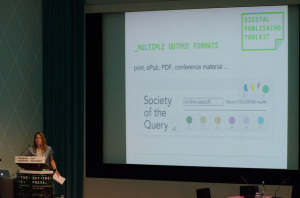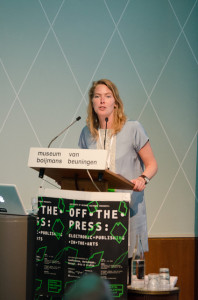Miriam Rasch, a co-editor (together with René König) of INC Reader #9, Society of the Query: Reflections on Web Search, presented the workflow she and her colleagues followed while working on the Reader. The Institute of Network Cultures project group involved:
Miriam went on to describe INC’s efforts to disseminate their publications. All the publications are distributed under Creative Commons license and the print copies can be ordered for free. INC uses a number of platforms (for instance ISUU) and file formats to expedite the distribution of its publications. They also introduced two innovative digital formats: iPad magazine and personal EPUB. The iPad magazine, designed to target a broader audience, features a selection of 10 articles from the Reader translated into Dutch, with added pictures and video clips. Due to its multimedia nature its only available on iPad. The personal EPUB is an interactive way of choosing articles of one’s interest (up to 10) from the INC database and compiling them into an e-book, in DIY fashion. Moreover, a variety of additional materials are available online, the most notable example being materials from a range of conferences organised by INC, like Society of the Query, Money Lab or Unlike Us. The conference materials, including pictures and video clips are available on Flickr and Vimeo. More information can be found on INC’s website.
 Society of the Query reader was put together following a print oriented workflow. The first step was the design of the PDF file, followed by the print version and an online PDF version on Issuu. Due to its format specificity, the EPUB file was created last, autonomously from the previous three. Miriam explained how her team changed their usual ‘print’ workflow to a hybrid workflow which is more sensitive to the several possible outputs, print or digital, which makes the proces of digital publishing easier and more efficient. In this proces the contents of the book were compiled into a single Word document and then formatted using Markdown syntax, which was then converted into HTML. The use of Markdown coding allows for easy and non-invasive conversion between different output formats.
Society of the Query reader was put together following a print oriented workflow. The first step was the design of the PDF file, followed by the print version and an online PDF version on Issuu. Due to its format specificity, the EPUB file was created last, autonomously from the previous three. Miriam explained how her team changed their usual ‘print’ workflow to a hybrid workflow which is more sensitive to the several possible outputs, print or digital, which makes the proces of digital publishing easier and more efficient. In this proces the contents of the book were compiled into a single Word document and then formatted using Markdown syntax, which was then converted into HTML. The use of Markdown coding allows for easy and non-invasive conversion between different output formats.
You can find a PDF of her original presentation here: Presentation Miriam Rasch
Miriam writes books reviews and guest posts for different websites and magazines. Look up her personal blog.



